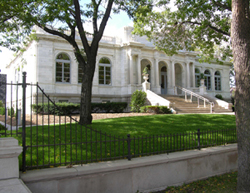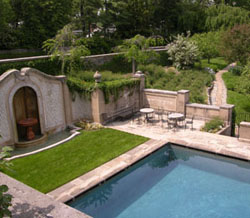Beaux Arts
- Neoclassical garden 1905-1930
 | Fig. 40 |
 | Fig. 41 |
Neoclassic estate-sized gardens
Estate gardens are designed in a revival of the classic Italian villa. The main elements are stone terraces, a grand staircase, grottoes, fountains and statuary. The best existing example is the Kikuit garden on the Rockefeller estate, in the Hudson Valley, designed by W.W. Bosworth. Its size allows it to create its own distant views beyond the formal garden near the house, with a natural English landscape.
 | Fig. 42 |
Although not in the Midwest, the garden at Dumbarton Oaks in Washington, DC, designed by Beatrix Ferrand, is the most masterful existing example of a large (10 acre) urban garden in the Neoclassic style. It incorporates French, English, and Italian garden elements to create garden rooms suitable for family use or entertaining. Created mainly between 1921 and 1941, it incorporates an orangery from 1810. Built to include a swimming pool, tennis court (now a pebble garden),
 | Fig. 43 |
Trees, Plantings at Dumbarton Oaks
Notable trees are the Katsura, Japanese maple, American beech (clipped into a 16’ high aerial hedge), and European beech. Plant selection includes interest in all seasons. Spring blooms include cherry trees, forsythia, wisteria, azaleas, dogwood, akebia (Zone 5), and magnolia.
 | Fig. 44 |
